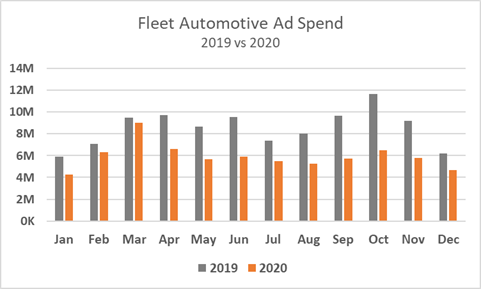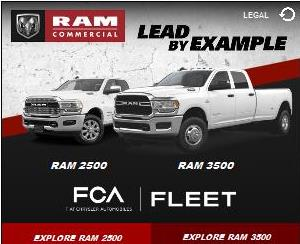Between consolidating companies, the push for electric fleets, and expanding infrastructure, the fleet management industry is undergoing massive change.
At the same time, fleet automotive advertisers are keeping their advertising budgets modest.
Will spending recover in 2021?
We encourage you to subscribe to our blog for the latest data surrounding the advertising industry. We will provide daily updates as COVID-19 continues to make its mark on the US economy.

eCommerce Drives Fleet Management Growth
While eCommerce grew significantly last year, the demand for fleet vehicles increased, and the market responded accordingly.
In December of 2020, Cox Automotives acquired Dickinson Fleet Services, or DFS, the most recent in a series of moves towards strengthening their fleet services brand, Pivet. The brand now includes an extensive fleet and fleet maintenance and management services.
Cox Automotives isn’t alone in bolstering its fleet business.
Earlier this month, GM debuted a new division, called BrightDrop, focused on B2B electric vehicles (EVs). GM and Brightdrop are responsible for everything from the battery technology for the electric vans to motorized transport boxes and software for cohesive fleet management, location services, and more.
Fleets Adding Electric Vehicles as Infrastructure Becomes More Widespread
FedEx will be the first to add BrightDrop products to their fleet, but other big names—such as WalMart and Amazon—have also been adding electrical vehicles to their fleets.
EVs are becoming increasingly popular, and the manufacturers offering them are already reaping the benefits. GM’s stock price rose 32% this month, at least in part due to enthusiasm over their EV-related plans.
“In 2021 as charging infrastructure grows, businesses recover and restart their fleet electrification plans, and state and federal tax incentives return, the American EV industry is poised to flourish anew, fulfilling, and perhaps even exceeding, expectations for growth,” explained Alison Alvarez, CEO of Analytics Company Blastpoint.
A ChargePoint report lists the top three reasons that fleets are increasingly adopting electric vehicles:
- The rising availability of EV models: The number of available electrical medium- and heavy-duty models is predicted to double by 2023.
- More affordability: EV models offer approximately 20-25% cost savings due to efficiency and lower maintenance fees.
- Environmental benefits: Corporations are becoming increasingly concerned about their environmental footprint and are taking the necessary actions to improve their impact.
As more manufacturers release EVs, others are building the infrastructure needed to support fleets. In 2020, an additional 6,000 charging stations were built across the US, and there was a 25% increase in the number of public charging stations.
MediaRadar Insights

Despite booming stock prices, ad spend for fleet automotive brands decreased in 2020.
In 2019 ad sales for fleet automotives reached $102 million across print and digital sales. In 2020, this total dropped 30%—to $71.2 million. However, the total number of brands advertising fell by only 7%, indicating that the drop in brands was not the cause of decreased spending.
In fact, fleet automotive ad sales started the year at a loss compared to 2019. The industry made progress towards improvement and YoY recovery in March, only to be set back again once the pandemic struck.
In March, the industry’s ad sales were only down by 5%. This ended up being an isolated incident, and YoY ad sales were down by as much as 44% in October.
The top 5 fleet automotive brands—Autel, Peterbilt, Isuzu, Chevrolet, and Ford—were responsible for only $4.5 million in 2020 ad spend (across print and digital), or 6% of the market total. We can infer that the rest of the 2400 brands in the industry also kept ad spending modest.
Though the industry is going through major changes, companies haven’t incorporated electric vehicles into their ad creatives yet. As we see, creative is mostly focused on function or service.



As companies continue rolling out new electric models and infrastructure, ad creative may begin to change and spending may begin to experience an uptick. However, there currently is no indication that spending is recovering quite yet.
For more updates like this, stay tuned. Subscribe to our blog for more updates on coronavirus and its mark on the economy.



